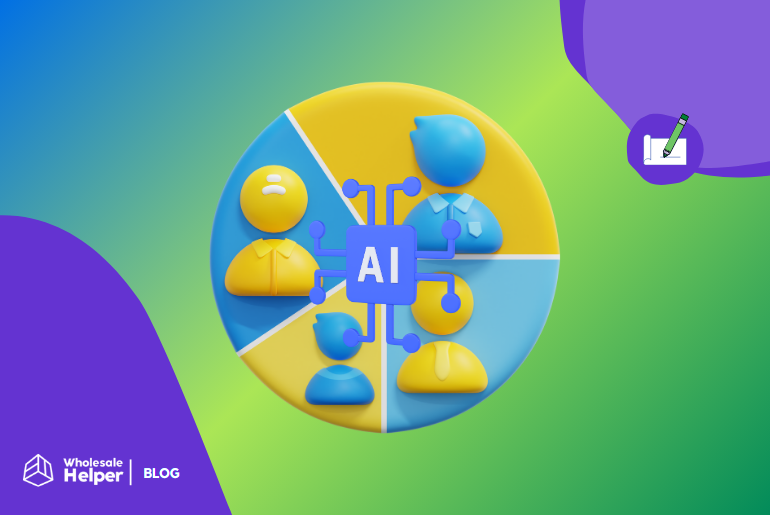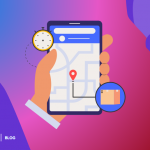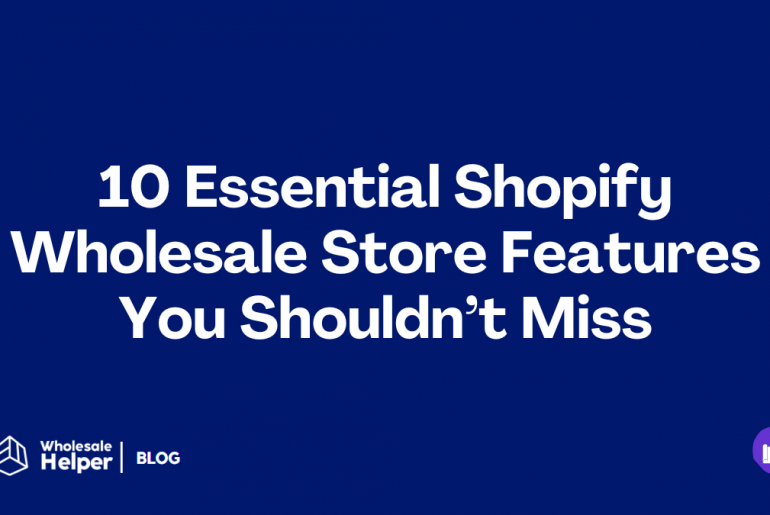The wholesale game has almost always been about volume—big orders, big clients, and, unfortunately, big generalizations. It’s an industry where “one size fits all” strategies are the norm, covering broad strokes that often gloss over the unique needs of individual clients. But with AI-driven customer segmentation stepping onto the field, the rules of wholesale distribution are getting a serious upgrade.
Imagine ditching those clunky spreadsheets for a sleek system that doesn’t just handle the influx of customer data—it weaponizes it into your ultimate competitive advantage. That’s the promise of AI-driven customer segmentation, where every buyer is seen, heard, and catered to—at scale. Intrigued? Stick around. In this blog, we’ll showcase how you can put this transformative technology to work in your wholesale operations.
What is AI-Driven Customer Segmentation?
AI-driven customer segmentation uses cutting-edge algorithms and machine learning techniques to separate your customer base into distinct, highly targeted groups. This isn’t the same as the traditional segmentation you’ve been doing with manual human efforts. Things get a whole lot better with AI.
A lot of conventional segmentation methods are based on demographic variables like gender, age, or occupation. AI and machine learning programs, on the other hand, drill down even deeper. It doesn’t just look at who your customers are. It examines how they behave, what they buy, and how often they make purchases, and even peels back layers to understand the sentiments driving their decisions. AI absorbs all this data, processes it, and churns out customer segments that are not just more refined but incredibly actionable.
The Sweet Benefits of AI in Customer Segmentation
Alright, let’s get into why AI-driven customer segmentation is the missing ingredient your wholesale business needs to leap from good to unstoppable. For businesses trying to stay competitive, these perks are like a dream checklist:
1. Efficiency at Scale
Manually segmenting a customer base the size of a packed football stadium is nightmare fuel for any sales manager in your team structure, right? But complexity is where AI really shines. The system effortlessly sorts through reams of data, automatically grouping clients according to their location, preferences, activity, and more. The result? A lightning-fast and pinpoint-accurate segmentation technique that will allow your team to concentrate on closing deals.
2. Planning and Allocating Resources Optimally
Nothing grinds a wholesaler’s gears more than wasted resources—be it time, budget, or human effort. Through AI-powered segmentation, though, one can tell where to channel their resources for the best resultant effect. This approach allows your marketing and sales teams to create strategies tailored to specific groups, maximizing your resources and ensuring every dollar you spend brings in better returns.
3. Crafting Custom Experiences
With AI technologies, personalization is no longer a luxury reserved for the few. It’s democratically available to businesses of all sizes—and your wholesale operation is no exception. Take tools like Supademo, an AI demo automation platform, for example. With Supademo, you can create tailored demo experiences that resonate with each customer, turning generic outreach into highly relevant, conversion-driving interactions. It’s personalization on overdrive—no more boilerplate pitches, just high-impact, relevant, and conversion-driven interactions that are intended to impress.
Forecasting Abilities
One of the things that AI can do and perhaps do best is predict the future – well at least the forecasts that relate to the behavior of the customer. Using AI-driven technology, you can analyze past data and forecast your customers’ actions. This analysis enables wholesalers to manage their inventories, have the right offers ready, and engage customers before they even know what they want.
Enhanced Customer Experience
Today’s customers expect more than just a transactional relationship with their suppliers. With the help of AI-driven segmentation, these focuses can be achieved as it enables clients to have a more interactive and responsive experience with the company. From offering customized products and services to unique offerings, AI helps you build stronger, more loyal customer relationships.
Using AI in Wholesale Operations (8 Important Steps)
AI-driven segmentation cannot simply be done with the push of a button. It is the application of such technology into the very core of wholesale business operations. Here’s how to do it in a way that no wires get crossed around:
Step 1: Data Aggregation
For AI to work its charms, it needs a fuel tank brimming with data. And it’s not just any data. We mean up to the hilt and the highest caliber data from all kinds of sources like past purchase dockets, client communication records, social media activity, and the rest. But perhaps the most important thing, all these have to be standardized and harmonized. Do away with the duplicates, bridge the gaps in the data, and bring all customer records to the same level.
Step 2: Pick Your AI Power Players
Let us be straight to the point, not every tool in the AI arsenal gets to cut it at a wholesale level. No, you need the heavy hitters capable of bearing the weight of your massive customer data and orders. Carry out some inquiries and choose tools that are not only compatible with the current systems being used but also those that will be required in the big leagues.
Step 3: Train the AI Models
Now, it is time for the interesting thing—training your AI models. In this step, you push your clean data into the AI and wait for it to search for relationships, figures or trends. This initial training process may take quite a while depending on the diversity of your customer base and how advanced your AI tools are, but the insights you’ll gain are worth the wait.
Step 4: Outline the Segmentation Criteria for Intended Target
After the AI is trained and humming along, it is very important to set the segmentation criteria to dictate the way in which consumers will be grouped. This could encompass their buying behavior, geographic position, level of engagement, and even behavioral predictions. Collaborate with your sales and marketing teams and decide what segmentation is most appropriate to your business: Is it focusing on high-value customers, frequent customers, or those who only purchase during promotions? These parameters are made clear to ensure that the strategies to be developed are very focused in execution.
Step 5: Bringing AI into Your Workflow
Looking at the further benefits of AI, you should integrate it properly in your existing wholesale operational systems. This may entail liaising with the IT department to determine the potential connections available with the AI system, for instance, pulling some statistics from the CRM/ERP/platforms used. The purpose of this is to achieve an interrelating system in which the insights from the AI can be operationalized.
Step 6: Make Sure There Is Secure and Intelligent Access
Use modern technology like QR codes that can allow your team safe and fast access to such AI facilities. This not only protects your data but also simplifies access, making your AI tools as easy as a scan away. But do not just purchase any QR code maker that you come across on the internet. Do your homework and choose one that’s the cream of the crop, ensuring that the security of your data isn’t left to chance.
Step 7: Allow AI to Assist You with Resource Allocation
Now that AI has advanced your segmentation strategy, the next step to be done is the appropriate allocation of resources. For example, if your AI indicates that certain product lines are selling quite well in certain regions, it’s your cue to tweak inventory, fine-tune marketing, and send your sales team where they’ll make the best impact. All you need to do is integrate your AI insights with resource management software or download an employee timesheet template from one of the reputed online sources and start doing some resource allocation assessment.
Step 8: Scale Up
Once you’ve seen success with your initial segmentation efforts, it’s time to scale up. Expand your segmentation criteria, find new instruments in AI and always make efforts more in a deeper understanding of your customer base. The most exciting thing about AI-powered customer segmentation is that it changes and advances along with the growth of the company and in fact, becomes stronger and more accurate the more data you feed it with.
Common Challenges in AI-Driven Customer Segmentation (And How to Avoid Them)
Here’s how to sidestep common mistakes that could put a dent in your AI-driven ambitions:
Challenge 1: Disregarding Customer Privacy
While your AI system hums along, make sure it’s playing by the rules—whether that’s GDPR, CCPA, or any other alphabet soup of data privacy laws. Beyond just compliance, make sure that your customers’ trust isn’t sacrificed at the altar of technological advancement. Transparency in how you use their data will go a long way in maintaining that trust.
Challenge 2: Excessive Reliance on AI
AI might be the powerhouse of your operation, but it shouldn’t be the only player on the field. Human factors are still very much needed as part of the equation. AI can churn out data-driven insights, but it’s up to your team to interpret and implement those insights in ways that resonate with real-world dynamics. Over-relying on AI can lead to missed nuances and opportunities, so ensure there’s a healthy balance between technology and human oversight.
Challenge 3: Neglecting Human Oversight
Regular assessments of your AI must be performed on a timely basis so that you can be sure that it remains on the course you want and that it answers your inquiries. This becomes more problematic, particularly when very large datasets have to be used, as even small errors may lead to extensive problems.
Final Words – Embracing AI in Wholesale
With AI leading the way, you can understand customer behavior with incredible accuracy, boost efficiency, and offer personalized experiences that once seemed impossible. AI-powered customer segmentation helps your wholesale business stay competitive and take the lead by using insights to turn opportunities into success.
Disclaimer: The views expressed in this article are those of the author and do not necessarily reflect the official policy or position of our organization. This content is for informational purposes only and should not be considered as professional advice.



![Top 11 Wholesale Suppliers In the UK [in 2024]](https://wholesalehelper.io/blog/wp-content/uploads/2024/11/Top-11-Wholesale-Suppliers-In-the-UK-in-2024-150x150.png)




